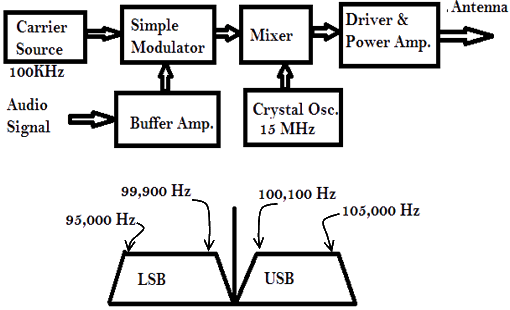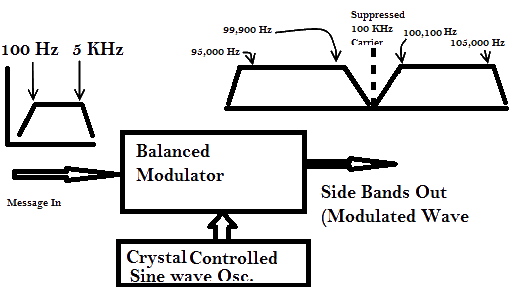DSB and DSB-SC Transmissions: An In-depth Analysis
Introduction:
Double-Sideband (DSB) and Double-Sideband Suppressed Carrier (DSB-SC) are modulation techniques used in communication systems to transmit information over radio frequency (RF) or microwave channels. These techniques offer unique advantages and challenges that make them valuable tools in various applications. In this article, we delve into the principles, characteristics, and applications of DSB and DSB-SC transmissions.
DSB Transmission:
Double-Sideband (DSB) transmission is a modulation technique in which both the upper and lower sidebands of a modulated signal are transmitted. It involves the amplitude modulation (AM) of the carrier signal with the message signal. The result is a signal containing two sidebands, each carrying a copy of the message signal.
Block Diagram
- To attain two side bands with the carrier. The carrier should be modulated with an audio signal by the simple modulator (Not a Balanced Modulator). Let the carrier frequency is 100 KHz and the audio frequency range is about 100 Hz to 5 KHz. After modulation, the result is LSB, USB, and Carrier. LSB is ranging between 95,000 Hz and the USB is ranging between 100100 Hz to 105,000 Hz. The carrier is 100 KHz.
- These two sidebands and the carrier are then fed to the mixer where they are mixed with the carrier of high frequency ( say 15 MHz depending upon transmission). The output frequency is thus raised to the value desired for transmission.
- Then these high-frequency double-side bands with carriers are amplified in driver and power amplifier stages and then fed to the aerial for the transmission

Characteristics of DSB Transmission:
Bandwidth Efficiency:
DSB transmission utilizes a wide bandwidth, as both sidebands are transmitted. This results in lower bandwidth efficiency compared to other modulation techniques.
Power Efficiency:
DSB transmission is power-efficient, as the carrier power is not completely wasted, unlike in other modulation schemes such as AM-SC (Amplitude Modulation with Suppressed Carrier).
Receiver Complexity:
The receiver for DSB transmission requires an envelope detector and a demodulator to extract the message signal. This simplicity makes DSB suitable for applications with limited complexity.
Applications of DSB Transmission:
AM Radio Broadcasting:
DSB is widely used in AM radio broadcasting due to its power efficiency and relatively simple receiver design.
Telephony:
DSB transmission was historically used in early telephony systems for voice communication over long distances.
DSB-SC Transmission:
Double-Sideband Suppressed Carrier (DSB-SC) transmission is a variant of DSB transmission where the carrier signal is completely suppressed, and only the sidebands are transmitted. This technique offers enhanced bandwidth efficiency compared to traditional DSB transmission.
DSB-SC Transmission
DSB-SC (Double sideband suppressed carrier) transmission is achieved by modulating a carrier with an audio signal through a balanced modulator. The block diagram shows such transmission.
- Message signal after amplification is fed to the balanced modulator whose frequency range is between 100 Hz to 5 KHz.
- A balanced modulator receives two input signals: the message signal and the carrier signal. The function of the balanced modulator is to generate an amplitude-modulated signal having two sidebands, at the same time canceling out the carrier signal.
- The upper sideband USB range includes the carrier plus the message frequencies; The lower sideband LSB range contains the carrier minus the message frequencies. This action is displayed in the figure.
- Notice that the separation between the lower and upper sidebands in the modulated signal is only 200 Hz in this example. the lower frequency in the message signal is the factor that determines the separation. From the figure, it is clear that the separation is two times the lowest message signal frequency.
- Then both sidebands are fed to the balanced mixer where the frequencies of the two sidebands are yet raised with the crystal oscillator or synthesizer.
- Then the signal is fed to the linear amplifiers to achieve sufficient power for transmission. This signal is then radiated from aerial to air.

Characteristics of DSB-SC Transmission:
Bandwidth Efficiency:
DSB-SC transmission is more bandwidth-efficient than DSB transmission, as it eliminates the need to transmit the carrier signal.
Power Efficiency:
DSB-SC transmission eliminates carrier power transmission, resulting in improved power efficiency.
Receiver Complexity:
The receiver for DSB-SC transmission is more complex than for DSB, as it requires coherent detection and a carrier signal regeneration circuit.
Applications of DSB-SC Transmission:
Single Sideband (SSB) Modulation:
DSB-SC serves as a basis for generating Single Sideband (SSB) signals, which further improve bandwidth efficiency and are used in applications like long-distance communication and radio astronomy.
Wireless Communication:
DSB-SC is employed in wireless communication systems for efficient spectrum utilization and reduced power consumption.
Conclusion: DSB and DSB-SC transmissions are modulation techniques that have played significant roles in various communication systems. While DSB offers simplicity and power efficiency at the cost of bandwidth efficiency, DSB-SC provides an improved compromise between these factors by eliminating the carrier signal. Both techniques find applications in broadcasting, telephony, and wireless communication, and even serve as the foundation for more advanced modulation schemes like Single Sideband (SSB) modulation. A thorough understanding of the characteristics and applications of DSB and DSB-SC transmissions is essential for designing efficient and reliable communication systems in the modern era.
